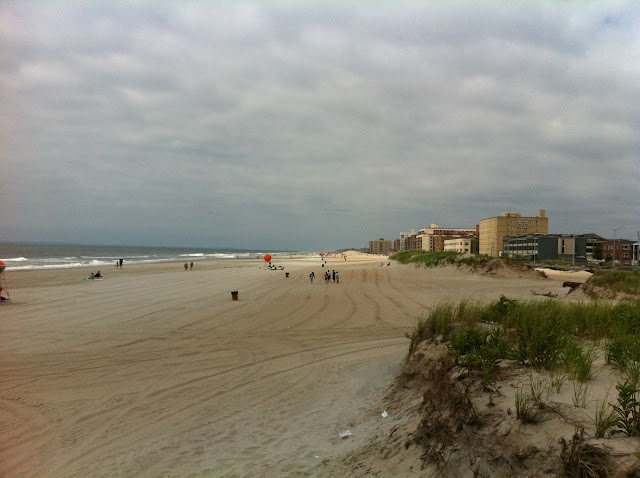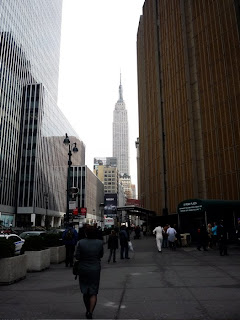The Long, Wide Beach at Rockaway
Compared to Coney Island's 2.5 mile boardwalk, the walk at Rockaway stretches a long 5.5 miles. Because of the size of this beach community in Queens on the south shore of Long Island, visitors on a day trip to Rockaway may not have enough time to experience all of its history and attractions except for a relatively small stretch of the beach. One such area of Rockaway worth exploring is the section between Beach 116th and Beach 105th Street. And by all means, take the beach towel and get your feet wet.
While Coney Island attracted the attention of visitors in the 19th century for its exceptional blue waters, early tourism guides to Rockaway Beach commented on the excellence of its beaches and opportunities for "surf-bathing." (See Illustrated hand-book of American summer resorts, Volume 21. D. Appleton, 1896)
Certainly in comparison to Coney Island, the waves are bigger here, and contemporary visitors to Rockaway may even encounter the odd sight of people carrying surfboards on the subway shuttle to the beach. The lifeguards, too, have the necessary surf boards for rescues. Rip tides are a danger at both beaches.
While stepping into the water and feeling the rush of the outward rip currents, it is easy to imagine how some of the historic structures that once lined this beach eventually washed away. Rockaway Beach in the 1880s, just like Coney Island, inspired big dreams.
Visions for Rockaway Beach, the 1880s
In 1880, 600 carpenters were at work on a mammoth hotel on Rockaway Beach. Its great wings stretched from what is now Beach 116th Street to Beach 110th Street. According to History of the Rockaways from the year 1685 to 1917 by Alfred Henry Bellot (Bellot's histories, inc., 1918, p. 105), the hotel's scale was so outsized that "Forty average persons could have walked up the main stairway arm in arm." The future of the hotel resort looked indeed promising -
Nearby, at the foot of 105th Street, a long iron pier of some 1200 feet, designed for a steamboat landing, was considered a marvel of engineering. A new four-mile bridge across Jamaica Bay was in the works, providing beach access via the New York, Woodhaven and Rockaway Beach Railroad. According to Railway World (March 27, 1880, p. 298), "A marine railway, connecting the iron pier and the hotel, is also about to be contracted for."
A reporter for The New York Times accompanied a group of businessmen to Rockaway in the off season - in fact, during a driving snow storm in February of 1880 - to learn about these newsworthy developments. They traveled by a special train, and the reporter dutifully noted all the hype. The iron pier attracted the most attention: "At high tide there will be 20 feet of water at the landing, and as the rise and fall of the tide is only between four and five feet, there will always be plenty of water for steamers." The pier had already withstood one large storm, but "not a pile was misplaced," as the reporter noted.
After warming themselves over coffee and a large meal at a nearby hotel, the party of businessmen took up an invitation to visit the new grand hotel and boarded a special train for the visit. It was snowing hard. When they arrived, workers were constructing the hotel, despite the driving snow. Wowed by the statistics of this PR event, the reporter faithfully cited the hotel's specs - the 1,030 foot building with each wing at 300 feet wide; accommodations for 1,300 to 1,500 guests; facilities to feed 7,000 guests at one time. (See "A Snow-Storm By the Sea - Visiting Rockaway on a Winter Day," February 16, 1880)
The hotel, the largest in the world at the time, turned quickly into an spectacular failure. One wing of the hotel opened in the summer of 1881, but financing was tenuous. Many of the construction workers were not paid and threatened to burn it down. The hotel never fully opened. It was sold for $30,000 in 1884 and torn down a few years later. Also, the great iron pier gradually washed away in several storms.
Contemporary visitors can still enjoy the sand and surf.
Directions: By subway - Take the Mott Av-Far Rockaway bound A Train to Broad Channel Station A/S. Transfer to the Rockaway Park - Beach 116th St. Get off at Rockaway Park - Beach 116th St. or earlier stops. From W. 4th St. in Manhattan, the trip is approximately 1 hour and 13 minutes. See MTA Trip Planner for personal itineraries.
View Rockaway Beach; Rockaway Park section in a larger map
• In a somber note of contemporary history, this section of Rockaway is the site of the crash of Flight 587, noted with a memorial at the food of Beach 116th Street. On November 12, 2001, a passenger flight from JFK Airport en route to the Dominican Republic crashed in the nearby residential neighborhood of Belle Harbor. The Flight 587 Memorial lists the names of the victims, most of whom were of Dominican descent and residents of the Washington Heights neighborhood in Upper Manhattan. The memorial was dedicated on November 12, 2006.
• Rip Tides - The National Weather Service's Surf Zone Forecast for area beaches includes safety tips for handling rip currents.
• Refreshments: A tasty place for refreshments in the Rockaway outpost of Caracas Arepas Bar, located on the boardwalk just west of Beach 105th Street. The Beach 105 St. subway stop for the A and S is also nearby.
Contemporary snapshots by Walking Off the Big Apple from June 17, 2012 made with an iPhone4 (top two images) and a waterproof single-use Kodak camera (bottom two photographs).
 |
| Rockaway Beach, looking west from where the Ocean Promenade Walkway bends at the Boardwalk, near Beach 109th Street. |
While Coney Island attracted the attention of visitors in the 19th century for its exceptional blue waters, early tourism guides to Rockaway Beach commented on the excellence of its beaches and opportunities for "surf-bathing." (See Illustrated hand-book of American summer resorts, Volume 21. D. Appleton, 1896)
Certainly in comparison to Coney Island, the waves are bigger here, and contemporary visitors to Rockaway may even encounter the odd sight of people carrying surfboards on the subway shuttle to the beach. The lifeguards, too, have the necessary surf boards for rescues. Rip tides are a danger at both beaches.
 |
| surf and sand, Rockaway Beach |
While stepping into the water and feeling the rush of the outward rip currents, it is easy to imagine how some of the historic structures that once lined this beach eventually washed away. Rockaway Beach in the 1880s, just like Coney Island, inspired big dreams.
Visions for Rockaway Beach, the 1880s
In 1880, 600 carpenters were at work on a mammoth hotel on Rockaway Beach. Its great wings stretched from what is now Beach 116th Street to Beach 110th Street. According to History of the Rockaways from the year 1685 to 1917 by Alfred Henry Bellot (Bellot's histories, inc., 1918, p. 105), the hotel's scale was so outsized that "Forty average persons could have walked up the main stairway arm in arm." The future of the hotel resort looked indeed promising -
"Rockaway Beach has a future at hand that promises to be as brilliant as that which Coney Island realized so quickly. So far it has all the natural qualifications for a great success. Since the opening of the mammoth new hotel, with its 560 rooms, public attention has been directed to it as a place for permanent location during the Summer months; and with the attractive features of this enormous building, it is expected that all of its facilities will be needed to meet the patronage of the coming year."
- "Long Island," Long Island Railroad Company, 1882.
Nearby, at the foot of 105th Street, a long iron pier of some 1200 feet, designed for a steamboat landing, was considered a marvel of engineering. A new four-mile bridge across Jamaica Bay was in the works, providing beach access via the New York, Woodhaven and Rockaway Beach Railroad. According to Railway World (March 27, 1880, p. 298), "A marine railway, connecting the iron pier and the hotel, is also about to be contracted for."
A reporter for The New York Times accompanied a group of businessmen to Rockaway in the off season - in fact, during a driving snow storm in February of 1880 - to learn about these newsworthy developments. They traveled by a special train, and the reporter dutifully noted all the hype. The iron pier attracted the most attention: "At high tide there will be 20 feet of water at the landing, and as the rise and fall of the tide is only between four and five feet, there will always be plenty of water for steamers." The pier had already withstood one large storm, but "not a pile was misplaced," as the reporter noted.
After warming themselves over coffee and a large meal at a nearby hotel, the party of businessmen took up an invitation to visit the new grand hotel and boarded a special train for the visit. It was snowing hard. When they arrived, workers were constructing the hotel, despite the driving snow. Wowed by the statistics of this PR event, the reporter faithfully cited the hotel's specs - the 1,030 foot building with each wing at 300 feet wide; accommodations for 1,300 to 1,500 guests; facilities to feed 7,000 guests at one time. (See "A Snow-Storm By the Sea - Visiting Rockaway on a Winter Day," February 16, 1880)
The hotel, the largest in the world at the time, turned quickly into an spectacular failure. One wing of the hotel opened in the summer of 1881, but financing was tenuous. Many of the construction workers were not paid and threatened to burn it down. The hotel never fully opened. It was sold for $30,000 in 1884 and torn down a few years later. Also, the great iron pier gradually washed away in several storms.
Contemporary visitors can still enjoy the sand and surf.
 |
| From the Library of Congress. On the beach at Rockaway, N.Y. [between 1900 and 1906] Detroit Publishing Co. no. 09036. |
Directions: By subway - Take the Mott Av-Far Rockaway bound A Train to Broad Channel Station A/S. Transfer to the Rockaway Park - Beach 116th St. Get off at Rockaway Park - Beach 116th St. or earlier stops. From W. 4th St. in Manhattan, the trip is approximately 1 hour and 13 minutes. See MTA Trip Planner for personal itineraries.
View Rockaway Beach; Rockaway Park section in a larger map
• In a somber note of contemporary history, this section of Rockaway is the site of the crash of Flight 587, noted with a memorial at the food of Beach 116th Street. On November 12, 2001, a passenger flight from JFK Airport en route to the Dominican Republic crashed in the nearby residential neighborhood of Belle Harbor. The Flight 587 Memorial lists the names of the victims, most of whom were of Dominican descent and residents of the Washington Heights neighborhood in Upper Manhattan. The memorial was dedicated on November 12, 2006.
• Rip Tides - The National Weather Service's Surf Zone Forecast for area beaches includes safety tips for handling rip currents.
• Refreshments: A tasty place for refreshments in the Rockaway outpost of Caracas Arepas Bar, located on the boardwalk just west of Beach 105th Street. The Beach 105 St. subway stop for the A and S is also nearby.
Contemporary snapshots by Walking Off the Big Apple from June 17, 2012 made with an iPhone4 (top two images) and a waterproof single-use Kodak camera (bottom two photographs).







Comments
Post a Comment